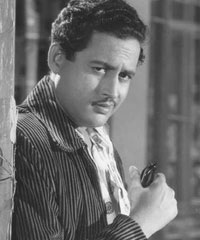|
Guru Dutt or
Vasanth Kumar Shivashankar Padukone (9 July 1925 - 10 October 1964) was
an Indian film director, producer and actor. He is often credited with
ushering in the golden era of Hindi cinema.
A village in South Kanara district of present day state Karnataka (then
Madras Province).
His father was initially a headmaster, and then a bank employee. His
mother Vasanthi,
while initially a housewife, later taught in a school, gave private
tuition and also wrote
short stories and translated Bengali novels into Kannada. Vasanthi was
only 16 when Guru Dutt was born.
Guru Dutt had a tough childhood with financial difficulties, and a
strained relationship between his parents. As a child he had some bad
experiences; the hostility from his maternal uncle's family, a
frightening encounter with his insane maternal adopted uncle, and the
death of his seven-month old brother Shashidhar.
Guru Dutt was initially named Vasanth Kumar at birth at the suggestion
of his mother's elder brother, but after a childhood accident, he was
renamed Guru Dutt, which was felt to be a more auspicious name. He was
joined by three younger brothers, Atmaram, Devidas and Vijay and a
younger sister, Lalitha. The Indian film director, Kalpana Lajmi, is his
sister's daughter.
He spent a great deal of time with his mother's cousin, Balakrishna B.
Benegal (known to the family as Bakutmama) who was a painter of cinema
posters. The Indian film director, Shyam Benegal, is the son of Sridhar
B. Benegal, Balakrishna's younger brother.
Guru Dutt wired home to say he had got the job of a telephone operator
at a Lever Brothers factory in Kolkata. But soon he disengaged himself
from the job, and joined his parents in Mumbai in 1944.
His sister recalls that at age 14 Guru Dutt would use his fingers to
shape images on a wall lit up by the flickering light of their
grandmotherís diya as she performed the evening arathi. Though
untrained, he could produce inspired movements as he did when he
persuaded his uncle, Benegal, to photograph him performing a snake
dance, based on a painting by the latter. The snake dance was later
performed at a gathering of Saraswat Brahmins at Calcutta for which Guru
Dutt was even given a cash prize of 5 Rupees. He was a good student, but
never went to college, partly because of financial troubles at home.
Instead, he joined the performing arts troupe of Uday Shankar, the older
brother of the better-known Ravi Shankar.
The Uday Shankar India Culture Center at Almora taught dance, drama, and
music. It aimed at combining the best of the Gurukula system with a
modern Arts University, and tried to turn out well-rounded students, at
home in many disciplines. A young Guru Dutt joined the center at age 16
in 1941 on a five-year scholarship of Rs. 75 annually (a lot of money
then), and studied at Almora until 1944, when the advancing World War II
forced the closing of the center.
Guru Dutt spoke fluent Bengali, and carried a distinct stamp of Bengali
culture in his work [citation needed]. Later, when he moved to then
Bombay now Mumbai in the 1940s, he dropped the Shivashankar Padukone
part of his name, and was known simply as Guru Dutt. Because Dutt is a
common Bengali last name, many people assumed that he was a Bengali.
He made quintessential 1950s and 1960s classics such as Pyaasa, Kaagaz
Ke Phool, Sahib Bibi Aur Ghulam and Chaudhvin Ka Chand.
In particular, Pyaasa and Kaagaz Ke Phool are now included among the
greatest films of all time, both by Time magazine's "All-TIME" 100 best
movies and by the Sight & Sound critics' and directors' poll, where Dutt
himself is included among the greatest film directors of all time.
He is sometimes referred to as "India's Orson Welles".In 2010, he has
been named the list
of CNN's "top 25 Asian actors of all time".
He is most famous for making lyrical and artistic films within the
context of popular Hindi cinema of the 1950s, and expanding its
commercial conventions, starting with his 1957 film, Pyaasa. Several of
his later works have a cult following. His movies go full house when
re-released; especially in Germany, France and Japan. The latest book on
him is Ten Years with Guru Dutt: Abrar Alvi's Journey by Sathya Saran
based on the recollections of his chief scriptwriter and friend.
Guru Dutt acted in a
small role as Sri Krishna in Chand in 1944. In 1945, he acted as well as
assisted director Vishram Bedekar in Lakhrani, and in 1946 he worked as an
assistant director and choreographed dances for P. L. Santoshiís film, Hum Ek
Hain.
This contract ended in 1947, but his mother got him a job as a freelance
assistant with Baburao Pai, the CEO of the Prabhat Film Company and Studio.
However, after that, for almost ten months, Guru Dutt was unemployed and stayed
with his family at Matunga, Mumbai. During this time, Guru Dutt developed a
flair for writing in English, and wrote short stories for The Illustrated Weekly
of India, a local weekly English magazine.
It is during this time that he is supposed to have written the script for the
almost autobiographical Pyaasa. Its original name was Kashmakash, which was
changed later to Pyaasa and was written at his home in Matunga.
It is in this phase of his life that Guru Dutt was almost married twice! The
first time he
eloped with a girl called Vijaya from Pune, and later his parents had him almost
married to his maternal niece, Suvarna, from Hyderabad.
In 1953, Dutt married Geeta Dutt, a well-known playback singer. They had been
engaged for three years and had to overcome a great deal of family opposition to
marry. They had three children, Tarun, Arun, and Nina.
Dutt had an unhappy marital life. According to his brother Atmaram, Guru Dutt
was "a strict disciplinarian as far as work was concerned, but totally
undisciplined in his personal life", He smoked heavily, drank heavily, and
kept odd hours. Guru Dutt's relationship with actress
Waheeda Rehman also worked against their
marriage. At the time of his death, he had separated from Geeta and was living
alone. Geeta Dutt herself died in 1972 at age 41, after excessive drinking which
resulted in liver damage. According to an interview with Abrar Alvi, one of
Dutt's close friends and his assistant director in films, Dutt did not "open up"
to discuss his thoughts and problems, even though they were spending many hours
together.
On 10 October 1964, Guru Dutt was found dead in his bed in his rented apartment
at Pedder Road in Mumbai. He is said to have been mixing alcohol and sleeping
pills. His death may have been suicide, or just an accidental overdose. It would
have been his third suicide attempt .
Guru Dutt's son, Arun Dutt views this as an accident in an interview with India
Abroad in October 2004 on the 40th anniversary of his father's death. Guru Dutt
had scheduled appointments the next day with actress, Mala Sinha for his movie,
Baharen Phir Bhi Aayengi, and Raj Kapoor to discuss
making colour films. According to him, "my father had sleeping disorders and
popped sleeping pills like any other person. That day he was drunk and had taken
an overdose of pills, which culminated in his death. It was a lethal combination
of excessive liquor and sleeping pills."
At the time of his death, Guru Dutt was involved in two other projects, Picnic
starring actress, Sadhana and Director K. Asif's epic, Love and God. Picnic
remained incomplete and Love and God was released two decades later with
Sanjeev Kumar replacing Dutt in the leading role.
The extra-feature on DVD of Kaagaz Ke Phool, has a 3 part Channel 4 produced
documentary on life and works of Guru Dutt titled, In Search of Guru Dutt. This
excellent and a must see for any Guru Dutt fan work includes interviews with
many who worked and lived with Guru Dutt.
Everyone, especially Abrar Alvi seem to suggest that it was a suicide. Abrar and
Guru Dutt sat late that night discussing a movie and during conversation
according to Alvi, Guru Dutt was very morbid in his thinking and conversation.
He was, according to many, distressed by his then personal situation - he was
not on terms with his wife, Geeta Dutt; Waheeda Rehman had distanced herself
from him. There was sleeping disorder that made him take sleeping pills, and he
had been drinking since 5:00 pm that evening.
Guru Dutt was a
director of it's own style.
Guru Dutt
Filmography as an Actor
Sanjh Aur Savera
(1964)
Suhagan (1964)
Bahurani (1963)
Bharosa (1963)
Sahib Bibi Aur Ghulam (1962)
Sautela Bhai (1962)
Chaudhvin Ka Chand (1960)
Kaagaz Ke Phool (1959)
12 O'Clock (1958)
Pyaasa (1957)
Mr. & Mrs. '55 (1955)
Aar Paar (1954)
Suhagan (1954)
Baaz (1953)
Hum Ek Hain (1946)
Lakha Rani (1945)
Chand (1944)
Guru Dutt
Filmography as an Director
Kaagaz Ke Phool (1959)
Pyaasa (1957)
Sailaab (1956)
Mr. & Mrs. '55 (1955)
Aar Paar (1954)
Baaz (1953)
Jaal (1952)
Baazi (1951)
|




|

